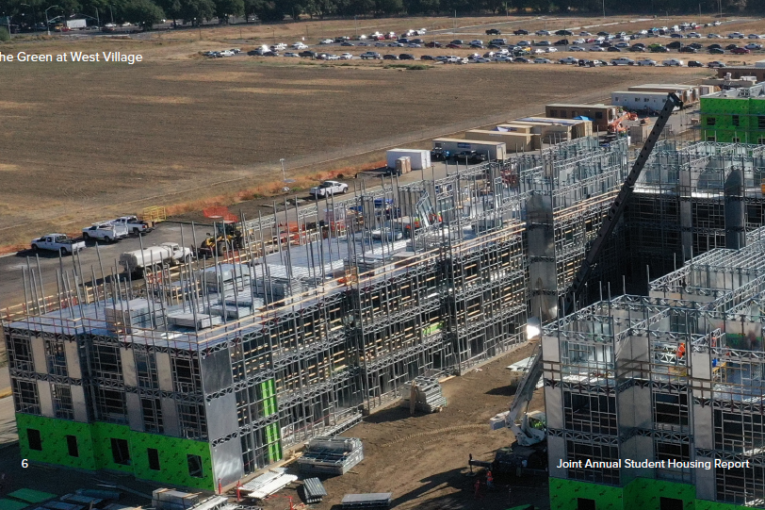

At the State of the City meeting back in February, the Mayor and City manager were excited to show the progress of the Green at West Village. UC Davis is hopeful of being able to open up to 3290 beds – 1000 in the fall and the remainder by 2021.
But despite some hopeful developments – agreement on an MOU, the building of 9050 beds on campus, progress has been slow and the impacts are unclear.
By 2030-31, UC Davis will be adding those 9050 beds on campus but at the same time, projecting to add another 5175 students projecting their enrollment to be 39,000 by that year over the LRDP base year which was 2016-17 – although already there are 35 to 36 thousand students expected to be enrolled.
By 2025, they expect about 6180 additional beds – half of which will be at West Village and another 1400 at Orchard Park.
An additional 2870 beds are planned between 2025 and 2030 these include 1470 at Solano Gateway Housing and then small additions at Segundo, Tercero, and housing for West Village faculty and staff (which are not including in student housing numbers).
At the end of the day, questions remain here. In town, so far we have approved about 3888 beds. Of those, only Sterling appears likely to open in 2020. The others have not been built yet, although ground will be laid at Lincoln40 shortly (it will have a name change at some point here). Nishi and its 2200 beds remain the subject of litigation.
As we have noted the strategy for housing has been centered around the idea of putting more housing on the UC Davis campus. The problem with that strategy as we noted in a commentary last week and in light of the UC Santa Cruz strikes and terminations, has been to pressure UC Davis to put more housing on campus.
But a key question here is whether that strategy will result in the type of affordability that many students are going to need.
To put it simply – on-campus housing for the most part has been more expensive than off-campus housing. There are lots of debates over how that could be.
For students in the residence halls, the answer is really simple. There are two significant added costs: those in residence halls have “live-in residence advisors, custodial services, social and academic programs, and provide students with access to our dining commons.”
A large added cost is in fact the dining service. More and more, apartments across town are putting utilities and amenities into the cost of rent – that means that students are provided with things like cable, internet, electricity, water, and garbage without having to make additional payments. But they end up paying a lot more for food on-campus where they have to use the dining  commons rather than on their own where some pay as little as $20 to $25 a week for food (and sometimes less if they qualify for the food pantry, for instance).
commons rather than on their own where some pay as little as $20 to $25 a week for food (and sometimes less if they qualify for the food pantry, for instance).
Matt Dulcich from UC Davis told the Vanguard this week: “Our on-campus housing such as Solano Park, Russell Park, Atriums, Primero Grove, The Colleges at La Rue and 8th & Wake all have rents that are currently below the averages in the Davis market.”
When we spoke to students about this, they were more skeptical about how that was calculated pointing out that they could split costs for rooms and housing for a good deal less in town whereas the cost for sharing rooms or even tripling up on rooms on-campus produced far less in the way of savings.
Mr. Dulcich did address another question we had. Initially we had reports that West Village was running at rates of vacancy approaching 17 percent. We were told however at that time, that this was an artifact of maintenance and not reflective of lack of demand.
Mr. Dulcich reports: “As of Oct. 1 2019, we housed 10,321 students on campus compared to 10,590 available beds, a vacancy rate of 2.5 percent.”
That’s of course much higher still than the city of Davis vacancy rate, but probably not so high as to be alarming.
Mr. Dulcich further noted: “we are in the midst of the most ambitious housing plan in the history of UC Davis. We are fully committed to our MOU with the City of Davis and Yolo County and are tracking to meet all targeted bed numbers. More beds provide more options for students and will improve the vacancy rate on campus and in the city of Davis.”
Still it seems that it might be advantageous for the community and students to monitor things like: rents on-campus and what those rents actually purchase, vacancy rate, and available beds.
Lawsuits against housing have not served either the community as a whole or students in particular very well. The lawsuit delayed Lincoln40 by up to two years and Lincoln40 was fortunate that the litigants missed a deadline or they would probably be delayed another year.
Nishi was not so fortunate and remains locked into litigation. This has produced ongoing frustration on the part of students, who last month, issued a rather terse statement.
—David M. Greenwald reporting







Much like grade school enrollments, it seems that the long-predicted decline in college enrollments is underway:
https://www.pressdemocrat.com/news/10683781-181/no-end-in-sight-for
Colleges such as Santa Rosa’s provide future students for the UC system.
(There’s lots of other articles regarding this trend, on the Internet.)
Ron, here’s a question for you. Are Santa Rosa Community College and UCD in any way comparable to one another?
My personal answer is that they aren’t, and painting UCD with a SRCC brush is either empty rhetoric or political spin.
Perhaps you missed this, Matt:
The article above is just something I came across. There’s tons of articles on the Internet, regarding the decline in college enrollments in California and across the country.
Some people like to pretend that UCD is so “special” that it won’t impact them.
Actually they say that about Harvard, but if the shoe fits.
Did you happen to notice the story in today’s Enterprise about the 2020 QS World University rankings, which ranked UCD #1 in the world for veterinary science and #2 in the world (and #1 in the US) for agriculture and forestry. UCD was ranked in the top 50 universities in the world in six of 48 disciplines. In addition to veterinary science and agriculture and forestry, they are:
environmental sciences (#16)
developmental studies (#27)
earth and marine sciences (tied for #41)
biological sciences (#42)
But, I suspect that universities (such as the UC system) are most vulnerable (financially) to a decline in International students.
https://www.nafsa.org/sites/default/files/media/document/nafsa-losing-talent.pdf
.
There really haven’t been any debates over why/how the new on-campus housing has been more expensive than off-campus housing.
Where there has been a debate, it has been about what can be done by UCD to transform expensive-to-build, high-cost housing into affordable-to-rent housing.
Actually there really isn’t any debate about what the solution is. It is quite clearly rent subsidies/offsets for the students.
The question really is how/where those subsidies will/can come from.
My personal opinion is that UCD doesn’t have the unrestricted fiscal resources to be able to come up with the needed subsidies/offsets themselves. Arguably the UC Office of the President doesn’t have a recurring source of those subsidy/offset resources either.
Agsin in my personal opinion, any commitment to greater housing affordability at UCD (and at all the other UCs as well) is going to have to come from Gavin Newsom. In November 2019 the Sacrameno Bee front page headline read “California is on track for a $7 billion budget surplus. Where will the money go?”
Newsom now has the benefit of the Super Tuesday election results, and he may want to reach out to both Sanders and Biden to enlist their help in a broad commitment to affordable higher education.
.
20/20 Hindsight is a wonderful thing. For the 2018 rendition of Nishi, the development team made the calculated decision, with the support of City leaders, to try and shoehorn the reconfigured project into the constraints of the 2016 EIR instead of adding six months to the process necessary for the focused update process that comes with creation of a supplemental EIR.
In retrospect that decision appears to have been penny wise and pound foolish. If the development team and the City had invested the time and dollars in the Supplemental EIR, that six-month investment (delaying the Measure R vote from March until November) probably would have stripped the litigants of their legal beef, and avoided years of litigation delays.
I personal;ly believe there is a lesson there that can be learned by both the City and the development team with respect to ARC. Right now they appear to be hell bent on rushing the process so that they can put a Measure R vote on the November ballot. Perhaps they should learn from history, and instead be targeting something in the first half of 2021. Perhaps there is a lesson to be learned from history.
I respectfully disagree… the litigation would have still occurred… it would not have stripped the litigants of their ability to bring suit… and the delays… all it would have done is increase the odds of the defendants prevailing when the matter actually reached the Court… particularly in Yolo County.
And the appropriate device would have likely been a focused EIR, not a “Supplemental” (yeah, going a bit ‘wonkish’)… actually their path of action has had probably little/no effect, of where the project is.
Exactly. Look at Lincoln40 which was not required to do an EIR and yet did it and was still sued.
Regarding Nishi, how long do you suppose it will take them to gain approval and start building the tunnel (under the railroad tracks), to UCD?
And, if they’re confident that something can ultimately be built, why wouldn’t they get started on that?
I wouldn’t be surprised if (regardless of the lawsuit), nothing is built there for a very long time. (At least long enough for another 100 articles on the Vanguard, complaining about it.)
How about exploring the actual issues in the lawsuit (e.g., regarding the Affordable housing)?
Always good to see the V covering new subject matter.
It’s all in how you word it, from March 1:
I did a count – 46 articles in the last week. You commented on just 10 of them. Given our small staff, I think we do a pretty good job of covering a range of issues. On the weekends we primarily feature opinion pieces rather than new news.
Only ten, says he, I’ll have to work on that . . . I’m sure DS would be thrilled if I’d commented on all 46. Hey, RO, want to comment on 46 articles/week?
. . . and how many of those 36 remaining articles had ZERO people comment on them? Am I expected to comment on those to get me stats up?
And how many of those were on so-called justice reform? A subject I’m not much interested in . . .
. . . not that it doesn’t have value . . . just not my ‘thing’ . . .